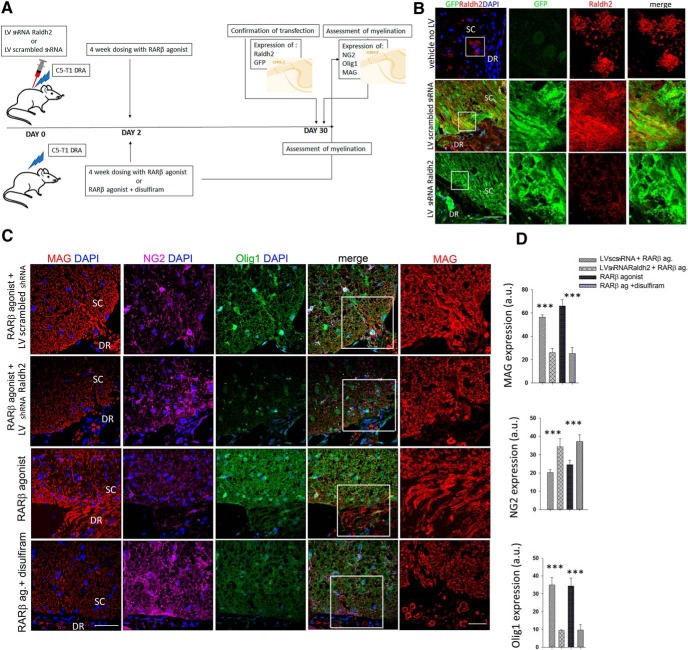Figure 7.
Raldh2 activity is required for differentiation of NG2+ cells into myelinating oligodendrocytes after DRA. A, Experimental design. Four groups of rats were subject to C5–T1 DRA. In two groups, an LV was injected at the lesion site (DREZ) at the time of surgery; one was an LV shRNA Raldh2 and the other a scrambled shRNA. All rats were treated for 4 weeks from day two after the surgery. All LV-injected rats received RARβ agonist (3× a week), another group received RARβ agonist only, and the fourth group received RARβ agonist and disulfiram. At the end of the treatment period, SCs with corresponding injured DRs were collected for protein expression analysis. LV transfection was confirmed by GFP and Raldh2 immunostaining from a subgroup of rats culled 2 weeks after injury. At the end of the treatment period, myelination was assessed by the quantification of NG2, Olig1, and MAG at the DREZ. B, Images of the DREZ from a control group that had not been transfected with LV. LV-transfected rats show expression of Raldh2 and GFP in the scrambled LV and very little of Raldh2 in shRNA Radh2 LV. Scale bar, 50 μm. C, Expression of MAG, NG2, and Olig1 at the DREZ in all four treatment groups. Scale bars, 50 and 20 μm for left inset images. D, Quantification of immunofluorescence expressed in arbitrary units (a.u.) taken from an area of 300 μm2 comprising the DREZ and adjacent PNS and CNS areas shows that MAG and Olig1 are significantly upregulated in scrambled LV- and RARβ-agonist-treated rats compared with Raldh2 shRNA LV- and RARβ agonist + disulfiram-treated rats. NG2 was significantly higher in these groups. Results are mean of fluorescence pixels ± SEM taken from 10 sections per animal from five rats per treatment group, **p ≤ 0.005, ***p ≤ 0.001, Student's t test.

